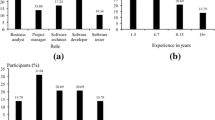Abstract
Prototyping in the development cycle claims to improve analyst understanding of system requirements leading to systems which match those requirements more closely. The quality of the end systems, from a user perspective, is thus improved. In this paper, the results of an empirical investigation into the use of prototyping in the development of various systems is described. Nine processes across eight different sites were analysed and data relating to each process was collected. The notation of Role Activity Diagrams (RADs) was used to capture each of the nine processes. Five hypotheses were then investigated: these related the prototyping role to features of other roles such as extent of interaction during the prototyping process, the effect site size had on the prototyping role and the dependence of the prototyping role on other roles in the prototyping process. Two coupling metrics were introduced to quantitatively analyse these RAD features. Results indicated a strong similarity between large and medium-sized sites in terms of interactions and behaviour. The prototyping process in small sites, however, was found to be different to large and medium-sized sites in both respects. The study demonstrates how measures of business models can aid analysis of the process as well as the products of systems development and highlights the need for more empirical investigation into this and other facets of the software development process.
Similar content being viewed by others
References
Basili, V.R. 1996. The role of experimentation in software engineering: Past, current, and future. Proc. 18th Int. Conf. Software Eng. pp. 442-449.
Basili, V.R., Briand, L.C., and Melo, W.L. 1996. A validation of object-oriented design metrics as quality indicators, IEEE Trans. Software Eng. 22(10): 751-761.
Brooks, J. 1987. People are our most important product. Software Engineering Education, Gibbs, E. and Fairley, R. (eds.), Springer-Verlag.
Card, D. 1995. The RAD fad: Istiming really everything? IEEE Software, Jan.: 19-22.
Carmel, E. 1995. Does RAD live up to the hype? IEEE Software, Jan.: 24-26.
Chen, L. 1997. An Empirical Investigation into Management andControl of Software Prototyping. Ph.D. dissertation, Department of Computing, Bournemouth University.
Coleman, G. and Verbruggen, R. 1998. A quality software process for rapid application development, Software Quality J. 7(2): 107-122.
Davis, A. 1992. Operational prototyping: A new development approach, IEEE software, pp. 70-78.
Fenton, N.E. and Pfleeger, S.L. 1996. Software Metrics, A Rigorous andPractical Approach, International Thomson Computer Press.
Gordon, V. and Bieman, J. 1993. Reported effects of rapid prototyping on industrial software quality, Software Quality J. 2(2): 93-108.
Gordon, V. and Bieman, J. 1995. Rapid prototyping: Lessons learned, IEEE Software, Jan.: 85-95 (reprinted in: Software Project Management: Readings and Cases, First Edition by C. Kemerer, Irwin Publishing, 1997).
Handy, R. 1976. Understanding Organisations, Penguin.
Harrison, R., Counsell, S.J., and Nithi, R. 1998. An evaluation of the MOOD set of object-oriented software metrics, IEEE Trans. Software Eng. 24(6): 491-496.
Lichter, H., Schneider-Hufschmidt, M., and Zullighoven, H. 1994. Prototyping in industrial software projects: Bridging the gap between theory and practice, IEEE Trans. Software Eng. 20(11): 825-832.
Lorenz, M. and Kidd, J. 1994. Object-OrientedSoftware Metrics, Prentice Hall Object-Oriented Series.
Miers, D. 1994. Business Process Re-Engineering: Myth and Reality, Kogan Page.
Ould, M. 1995. Business Processes: Modelling andAnalysis for Rengineering andImprovement, New York, Wiley.
Ould, M. and Roberts, C. 1986. Modelling iteration in the software process. 3rdInt. Software Process Workshop, Colorado, USA.
Phalp, K. and Counsell, S. 1997. Counts and heuristics for static process models. Proc. ICSE Workshop on Process Modelling and Software Evolution, Boston, USA.
Phalp, K. and Counsell, S. 2000. The application of metrics to industrial prototyping processes: An empirical study. Software Process Technology, Ed. R. Conradi, Springer-Verlag Series, 1780: 239-248.
Phalp, K. and Sheppered, M. 1999. Analysing process models quantitatively. Empirical Assessment in Software Engineering (EASE'99) Keele, Staffordshire, UK.
Reilly, J. 1995. Does RAD live up to the hype? IEEE Software, Jan.: 24-26.
Author information
Authors and Affiliations
Rights and permissions
About this article
Cite this article
Phalp, K., Counsell, S. Coupling Trends in Industrial Prototyping Roles: An Empirical Investigation. Software Quality Journal 9, 223–240 (2001). https://doi.org/10.1023/A:1013858918910
Issue Date:
DOI: https://doi.org/10.1023/A:1013858918910




